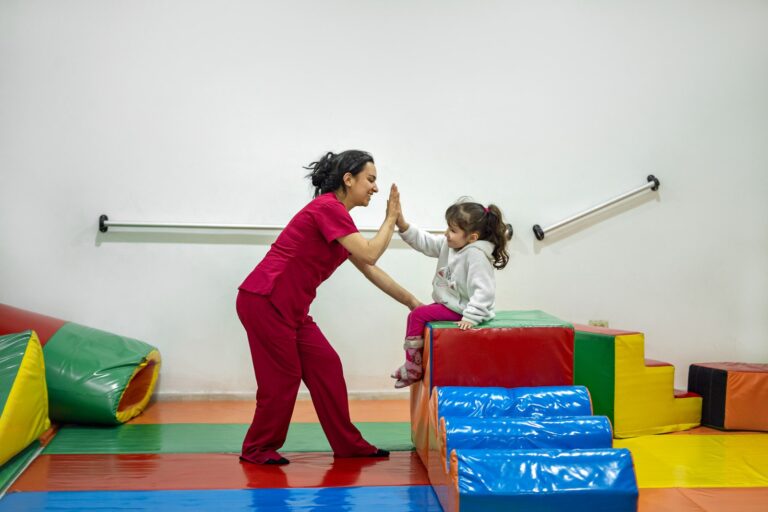Occupational therapy (OT) is more than a healthcare service; it is a science-driven approach to improving quality of life. Combining psychology, biology, and social sciences, OT aims to empower individuals to overcome physical, emotional, and cognitive challenges. This blog delves into the principles and science behind occupational therapy, unraveling how it transforms lives.
The Core Principles of Occupational Therapy
Occupational therapy is built on several fundamental principles that ensure its effectiveness:
- Client-Centered Care: Every individual’s therapy plan is tailored to their unique goals, needs, and circumstances.
- Holistic Approach: OT addresses not just the physical but also the emotional and social aspects of a person’s life.
- Evidence-Based Practice: Therapists rely on the latest research to provide scientifically supported interventions.
- Goal-Oriented Strategies: Therapy focuses on enabling individuals to achieve specific, measurable objectives.

The Science of Rehabilitation and Adaptation
Occupational therapy integrates various scientific disciplines to enable rehabilitation and adaptation.
- Neuroscience: Understanding brain functions is crucial in designing interventions for neurological disorders. Techniques like neuroplasticity are leveraged to retrain the brain.
- Kinesiology: The study of human movement helps therapists guide clients in restoring physical capabilities.
- Behavioral Psychology: Techniques are used to help individuals develop healthy habits and coping mechanisms.
- Assistive Technology: Tools such as prosthetics and adaptive devices are often employed to enhance independence.
How Occupational Therapy Works
Occupational therapy operates through a systematic process:
- Assessment: Evaluating the client’s abilities, environment, and personal goals.
- Planning: Developing a customized intervention plan.
- Implementation: Applying therapeutic techniques and assistive tools to achieve the set objectives.
- Evaluation: Continuously monitoring progress and making necessary adjustments.
Case Studies: Real-World Impact of OT
Occupational therapy has countless success stories that showcase its transformative impact.
- Stroke Recovery: A stroke survivor regains mobility through tailored exercises and tools.
- Autism Support: Children with autism achieve milestones in communication and daily routines through sensory integration therapy.
- Workplace Reintegration: An injured worker returns to their job with the help of ergonomic assessments and training.
The Role of Technology in Occupational Therapy
Technology has revolutionized occupational therapy practices:
- Virtual Reality (VR): VR simulations are used for pain management and motor skill rehabilitation.
- Wearable Devices: Smart devices track movements and provide feedback for improved therapy outcomes.
- Teletherapy: Online sessions ensure access to therapy for remote clients.
Benefits Backed by Research
Scientific studies validate the benefits of occupational therapy, including:
- Improved independence in daily activities.
- Enhanced cognitive and physical functioning.
- Reduced stress and improved emotional well-being.
Collaboration in OT: Therapists, Clients, and Families
The collaborative nature of OT involves therapists working alongside clients and their families. This team approach ensures that therapy aligns with the client’s personal and social environment, fostering better outcomes.
Addressing Common Misconceptions
There are several myths surrounding occupational therapy, such as:
- Myth: OT is only for physical injuries.
Fact: OT also addresses mental health, developmental disorders, and more. - Myth: It’s the same as physical therapy.
Fact: OT focuses on enabling individuals to perform daily activities, whereas physical therapy emphasizes physical rehabilitation.
The Future of Occupational Therapy: Trends and Innovations
Occupational therapy continues to evolve, integrating advancements in technology and new methodologies to enhance outcomes. Understanding these trends sheds light on the future potential of OT.
Emerging Trends in Occupational Therapy
- AI Integration: Artificial Intelligence (AI) is playing a growing role in therapy assessments, helping therapists identify subtle patterns in client behaviors.
- Robotics in Rehabilitation: Robotic devices, such as exoskeletons, aid in mobility training and physical rehabilitation.
- Data-Driven Therapy: Big data is being used to analyze the success rates of different therapy approaches, enabling therapists to refine their strategies.
- Personalized Genomics: Genetic data may soon inform therapy plans, particularly in cases of neurological or developmental disorders.
Expanding Access to Occupational Therapy Services
Efforts are being made globally to expand access to OT services. This includes teletherapy, mobile therapy units for rural areas, and initiatives to make assistive devices more affordable and widely available.
The Role of Advocacy in Promoting OT
Occupational therapy advocates are working to raise awareness about its benefits. Educational campaigns, community outreach programs, and policy reforms are critical for ensuring that more people can access these life-changing services.
The Emotional and Social Impact of Occupational Therapy
Beyond physical improvements, occupational therapy brings profound emotional and social benefits.
- Emotional Growth: Therapy helps individuals build self-confidence, reduce anxiety, and overcome feelings of helplessness.
- Social Integration: OT facilitates smoother reintegration into workplaces, schools, and social settings, fostering a sense of belonging and independence.
Real-Life Impact: Personal Stories of Triumph
Success stories abound in occupational therapy. Consider the example of a young adult with cerebral palsy who, through customized therapy and adaptive tools, now leads an independent life as a software engineer. These stories highlight the transformative power of OT.

Occupational Therapy in Mental Health
While often associated with physical rehabilitation, OT also plays a critical role in mental health.
- Stress Management: Techniques like mindfulness and activity scheduling help reduce stress and anxiety.
- Skill Development: OT aids individuals in building routines and coping mechanisms for better mental well-being.
- Group Therapy: Engaging in shared activities fosters social connections, which are crucial for mental health recovery.
Conclusion
Occupational therapy is a multidisciplinary science that empowers individuals to live their lives to the fullest. From its evidence-based practices to its innovative use of technology, OT stands as a beacon of hope for those facing challenges. By addressing physical, emotional, and social aspects, OT ensures holistic care that truly changes lives.







